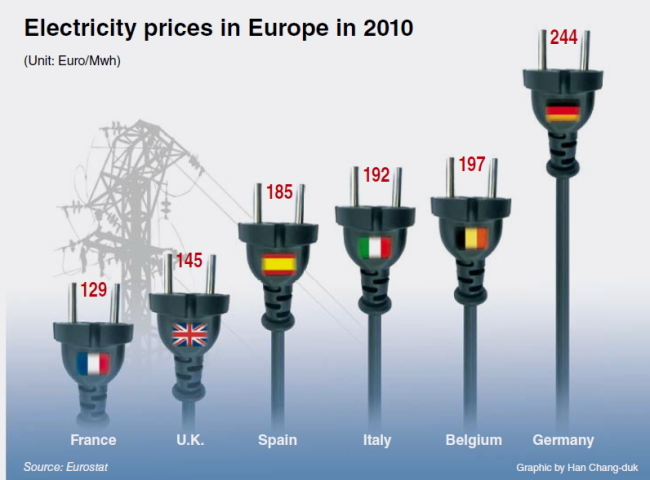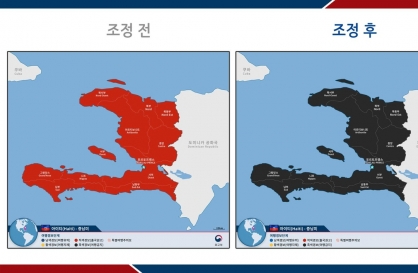Uncertainties linger over Germany’s renewable energy transition
High costs make road to reliance on renewables a tough one to navigate
By Seo Jee-yeonPublished : March 18, 2013 - 19:50
BERLIN ― The Fukushima nuclear disaster has affected the world’s nuclear energy policy for the past two years. Countries such as Germany have since undergone drastic changes in their nuclear energy policy in response to rising concerns over the safety of nuclear power plants.
In May 2011, two months after the Fukushima nuclear accident, the German government immediately decided to shut down eight aged nuclear power plants. In July, Europe’s biggest economy announced that it would close its nine remaining nuclear power plants by 2022.
While phasing out nuclear power, which generated 17 percent of Germany’s total electricity in 2011, the German government has accelerated its shift to renewable energy sources, including wind, solar, geothermal and bioenergy. The country plans to increase its dependency rate to 35 percent by 2020 and to 80 percent by 2050.
“The transition to renewables was discussed for many years, but the speed became much faster than we anticipated after the Fukushima disaster,” said Matthias Riebel from EnBW, the third-largest power supplier in Germany and the operator of two nuclear power plants.
“A total of 16 states of Germany are pushing for their own plans to expand renewable energy sources, depending on their natural conditions and public acceptance.”
Village powered by renewable energies
The successes of Germany’s energy transition drive have become world benchmarks. The tiny village of Feldheim in Brandenburg, 60 kilometers from Berlin, is one such case: The small community with a population of 145 is powered solely by renewable energies, ranging from wind power to solar power to biogas.
“The village is lit up by electricity generated from wind and solar power, while heated by power generated from biogas,” said Sigfried Kappert, a village tour guide.
Wind power is the biggest green energy source that the village produces. Forty-three wind turbines built in the fields surrounding the village generate an average of 75 megawatts per year.
The biogas plant, built in 2008 in the middle of the village, also generates 500 kilowatts electricity from pig and cow manure per year. Solar panels with a capacity of 8 kilowatts are also installed in what it calls a “solar park” 7 km from the village.
Green energy generated in the village is sent to Energyquelle, a German private power company focusing on green energy businesses, and the power company distributes electricity to the village at a 30 percent discount compared with neighboring villages, in return for green power generation.
The village has attracted attention from a number of countries considering energy transition to renewables.
“We have about 3,000 visitors from all around the world every year. The renewable energy tour has become another income source for the village,” said Kappert.
Behind the success of Feldheim was, most of all, public acceptance of the cost required to transition to renewables.
“Households in the village agreed to pay 3,000 euros ($3,900) to build a power grid for using renewable energies and to lend part of their land to the power company for facility installments,” said Kappert.

Rising cost for energy transition
Despite continued investments in renewable power, debate over the future of Germany’s energy transition is heating up due in part to mounting costs and the instability of renewable energy generation.
Kerstin Tzschoppe, who lives in Brandenburg with her husband, started feeling the pinch from the continued electricity price hikes, caused by Germany’s renewable energy transition.
“The government raised the electricity rate by 5 euros from March this year, again in two years (after a rise in 2011) to fund infrastructure construction for renewable energy. I am not against the government’s energy transition policy, but I am not sure that I can bear with continued increases of utility costs.”
Germany’s electricity price for consumers is already almost double that of France which depends highly on nuclear power plants for a cheap, steady electricity supply.
The government tries to subdue complaints from energy-consuming industries such as steel over rising prices of electricity by subsidizing part of the rate.
“Renewable energies have limits in that they require a huge cost to build infrastructure for renewable power usage and to build power-generating facilities,” Riebel from EnBW said.
German Energy and Environment Minister Peter Altmaier has recently admitted publicly that the cost to transition the country’s energy system to one reliant on renewable power is likely to reach 1 trillion euros.
Another key limit of renewable power is instability in the supply of renewable power. “Wind and solar farms need consistent wind and solar for power generation, which is difficult to control by nature,” he said.
Despite these disadvantages, one of the key reasons behind the German government’s energy transition drive is to cultivate the new industry to become a growth engine for the economy.
“Data showed about 400,000 jobs have been created in the renewable energy sector and the advanced technology will boost German exports in this sector later,” Riebel said.
“(Regarding the energy transition to renewables), there is still the lingering question of why we do that and how it will be put into reality. A big discussion is under way over how to finance different elements we need for a successful transition.”
By Seo Jee-yeon, Korea Herald correspondent
(jyseo@heraldcorp.com)
In May 2011, two months after the Fukushima nuclear accident, the German government immediately decided to shut down eight aged nuclear power plants. In July, Europe’s biggest economy announced that it would close its nine remaining nuclear power plants by 2022.
While phasing out nuclear power, which generated 17 percent of Germany’s total electricity in 2011, the German government has accelerated its shift to renewable energy sources, including wind, solar, geothermal and bioenergy. The country plans to increase its dependency rate to 35 percent by 2020 and to 80 percent by 2050.
“The transition to renewables was discussed for many years, but the speed became much faster than we anticipated after the Fukushima disaster,” said Matthias Riebel from EnBW, the third-largest power supplier in Germany and the operator of two nuclear power plants.
“A total of 16 states of Germany are pushing for their own plans to expand renewable energy sources, depending on their natural conditions and public acceptance.”
Village powered by renewable energies
The successes of Germany’s energy transition drive have become world benchmarks. The tiny village of Feldheim in Brandenburg, 60 kilometers from Berlin, is one such case: The small community with a population of 145 is powered solely by renewable energies, ranging from wind power to solar power to biogas.
“The village is lit up by electricity generated from wind and solar power, while heated by power generated from biogas,” said Sigfried Kappert, a village tour guide.
Wind power is the biggest green energy source that the village produces. Forty-three wind turbines built in the fields surrounding the village generate an average of 75 megawatts per year.
The biogas plant, built in 2008 in the middle of the village, also generates 500 kilowatts electricity from pig and cow manure per year. Solar panels with a capacity of 8 kilowatts are also installed in what it calls a “solar park” 7 km from the village.
Green energy generated in the village is sent to Energyquelle, a German private power company focusing on green energy businesses, and the power company distributes electricity to the village at a 30 percent discount compared with neighboring villages, in return for green power generation.
The village has attracted attention from a number of countries considering energy transition to renewables.
“We have about 3,000 visitors from all around the world every year. The renewable energy tour has become another income source for the village,” said Kappert.
Behind the success of Feldheim was, most of all, public acceptance of the cost required to transition to renewables.
“Households in the village agreed to pay 3,000 euros ($3,900) to build a power grid for using renewable energies and to lend part of their land to the power company for facility installments,” said Kappert.

Rising cost for energy transition
Despite continued investments in renewable power, debate over the future of Germany’s energy transition is heating up due in part to mounting costs and the instability of renewable energy generation.
Kerstin Tzschoppe, who lives in Brandenburg with her husband, started feeling the pinch from the continued electricity price hikes, caused by Germany’s renewable energy transition.
“The government raised the electricity rate by 5 euros from March this year, again in two years (after a rise in 2011) to fund infrastructure construction for renewable energy. I am not against the government’s energy transition policy, but I am not sure that I can bear with continued increases of utility costs.”
Germany’s electricity price for consumers is already almost double that of France which depends highly on nuclear power plants for a cheap, steady electricity supply.
The government tries to subdue complaints from energy-consuming industries such as steel over rising prices of electricity by subsidizing part of the rate.
“Renewable energies have limits in that they require a huge cost to build infrastructure for renewable power usage and to build power-generating facilities,” Riebel from EnBW said.
German Energy and Environment Minister Peter Altmaier has recently admitted publicly that the cost to transition the country’s energy system to one reliant on renewable power is likely to reach 1 trillion euros.
Another key limit of renewable power is instability in the supply of renewable power. “Wind and solar farms need consistent wind and solar for power generation, which is difficult to control by nature,” he said.
Despite these disadvantages, one of the key reasons behind the German government’s energy transition drive is to cultivate the new industry to become a growth engine for the economy.
“Data showed about 400,000 jobs have been created in the renewable energy sector and the advanced technology will boost German exports in this sector later,” Riebel said.
“(Regarding the energy transition to renewables), there is still the lingering question of why we do that and how it will be put into reality. A big discussion is under way over how to finance different elements we need for a successful transition.”
By Seo Jee-yeon, Korea Herald correspondent
(jyseo@heraldcorp.com)


















